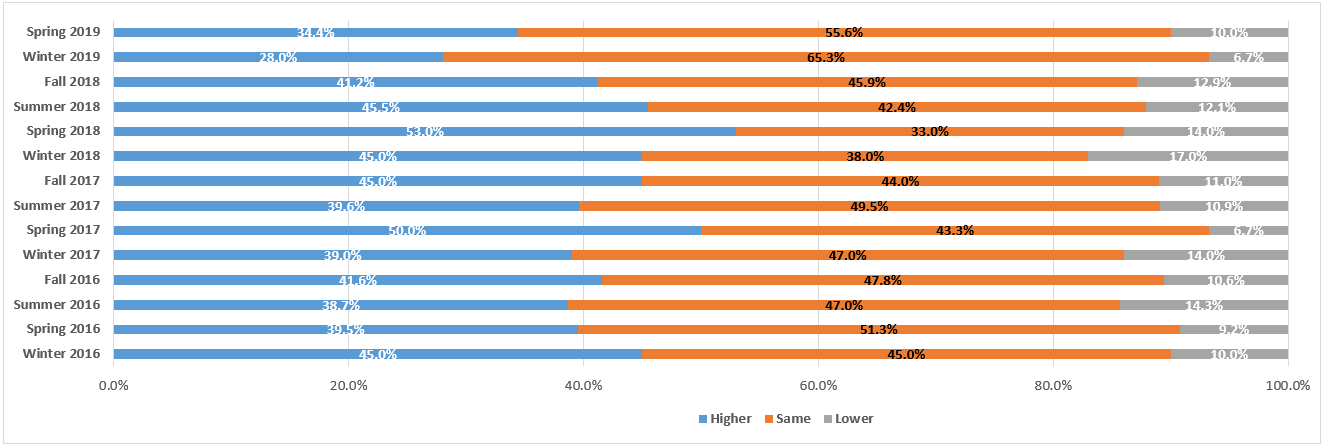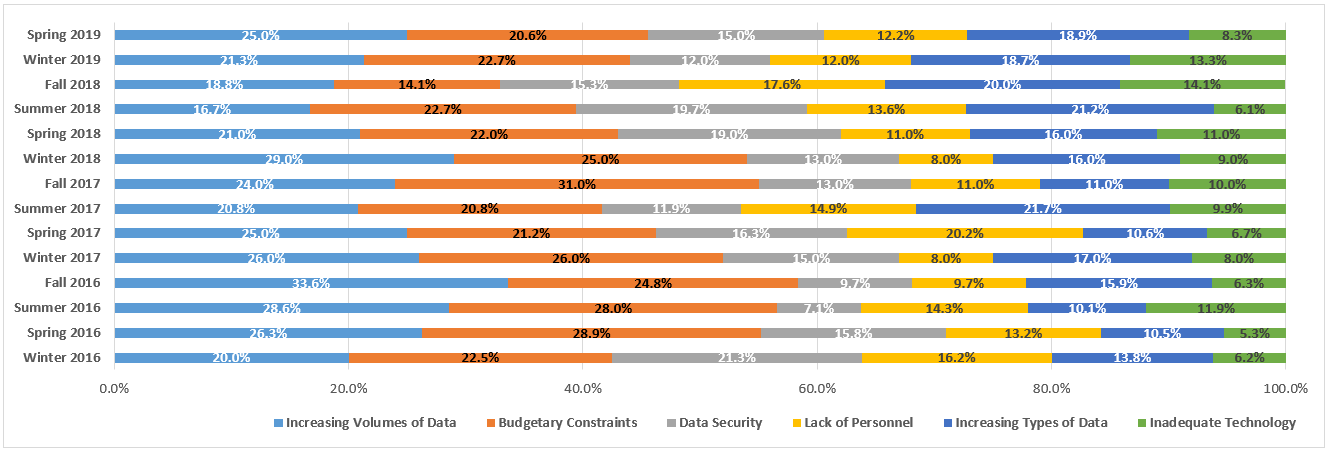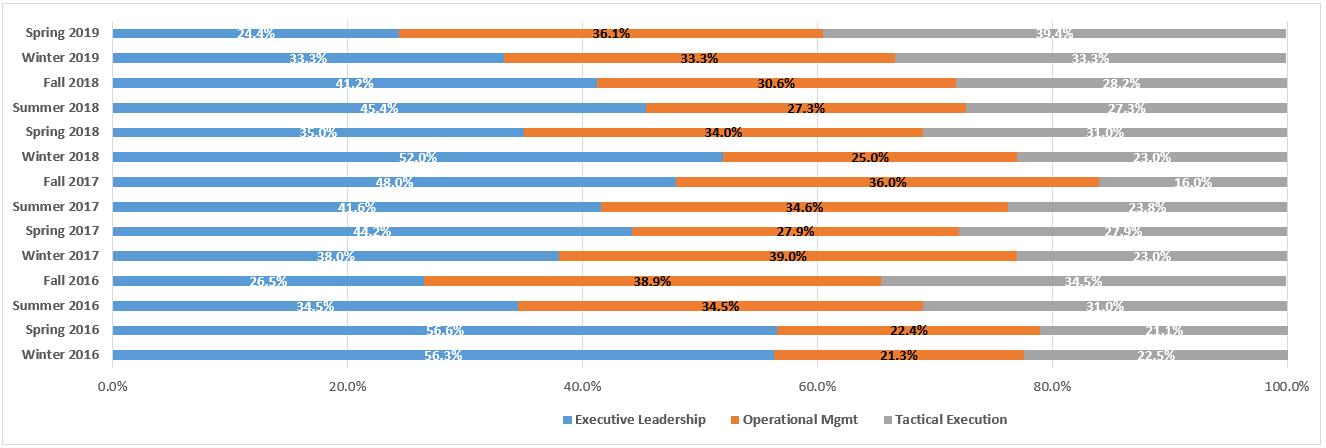eDiscovery Daily Blog
What Does a Record Number of Responses Show Regarding eDiscovery Business Confidence?: eDiscovery Trends
As promised yesterday, I’m here to cover the results of the Spring 2019 eDiscovery Business Confidence Survey, published (as always) on Rob Robinson’s terrific Complex Discovery site. So, how confident are individuals working in the eDiscovery ecosystem in the business of eDiscovery? Let’s see.
As always, Rob provides a complete breakdown of the latest survey results, which you can check out here. As I’ve done for the past few surveys, I will provide some analysis and I’m continuing to take a look at all surveys conducted to look at trends over time. So, this time, I will look at the results for all fourteen surveys to date, from January 2016 to present.
The Spring 2019 Survey response period was initiated on April 1 (no fooling!) and continued until registration of 180(!) responses last week, a record number of participants, thanks in part to support and promotion from the Association of Certified E-Discovery Specialists (ACEDS).
Law Firms Lead the Way: It’s rare when Software and/or Services Provider respondents aren’t the top group, but this is one of those times – barely. Law Firm respondents led the way at 30% of all respondents, with Software and/or Services Provider respondents less than a tick behind at 29.4%. Corporation respondents were third at 16.7%, a record percentage of corporate respondents and Consultancy was fourth at 12.8%. If you count law firms as providers (they’re technically both providers and consumers), this is still a provider heavy survey with 72.2% of total respondents (but it’s the lowest since Fall 2016, which I believe was the previous highest participant count ever). So, expanding the respondents seems to diversify the responses a bit! Here’s a graphical representation of the trend over the fourteen surveys to date:

So, how confident is the largest group of respondents ever in eDiscovery business confidence? See below.
Most Respondents Consider Business to Be Same Old, Same Old: For the first time ever, more than half (52.2%) of respondents considered business to be normal, considerably more than the 36% we had last quarter. And, only 41.1% of respondents consider business to be good – the lowest number ever. 6.7% of respondents rated business conditions as bad, which is a four percent drop from last quarter. So, does a larger group of respondents means we get more info from the companies that are not thriving as much? Hmmm… Here is the trend over the fourteen surveys to date:

So, how good do respondents expect business to be in six months? See below.
Middling Numbers for Six Months From Now, As Well: While most respondents (97.8%) expect business conditions will be in their segment to be the same or better six months from now, the percentage expecting business to be better dropped 12 percent to 40%, while the percentage expecting business to be the same rose to 57.8%. Revenue numbers were comparable to last quarter, slightly more respondents predicting higher revenue (41.7%, up .4 percent) and same (52.2%, up 1.5 percent). Profit expectations (combined 90%) dropped 3.3 points from last quarter, but those expecting higher profits did rebound a bit to 34.4% – 6.4 percent more than last quarter’s all-time low, but still the second lowest all-time. Here is the profits trend over the fourteen surveys to date:

Will the lower future profits predictions continue? We’ll see.
Volume, Volume, Volume! Increasing Volumes of Data Considered to Be Most Impactful to eDiscovery Business: After two quarters as the runner up, Increasing Volumes of Data returned as the top impactful issue at 25%. Budgetary Constraints moved down a notch back to second at 20.6%, so, as has been the case most quarters, those two factors have been the top two. Increasing Types of Data was once again third at 18.9%, followed by Data Security at 15%. Lack of Personnel was fifth at 12.2%, with Inadequate Technology bringing up the rear at 8.3%. The graph below illustrates the distribution over the fourteen surveys to date:

Increased volumes lead to increased costs, so it’s not surprising that Increasing Volumes of Data and Budgetary Constraints are normally one and two.
Let’s Get Tactical!: For the first time ever, Tactical Execution respondents were the clear top group at 39.4%, a record percentage by nearly 5 percent (previous high was 34.5 percent in Fall 2016). So, again, greater turnout means a greater response from the people doing most of the front-line work. Operational Management respondents were second at 36.1% and Executive Leadership respondents were at 24.4%, the lowest ever (previous low was 26.5 percent in, of course, Fall 2016). Here’s the breakdown over the fourteen surveys to date:

With more respondents than ever, it’s clear that it’s not the same people giving the same answers each time. Personally, I like the expanded respondents, more diverse survey results! Let’s keep going Kramer!
Again, Rob has published the results on his site here, which shows responses to additional questions not referenced here including an early look at responses to three recently added questions. Check them out.
So, what do you think? What’s your state of confidence in the business of eDiscovery? Please share any comments you might have or if you’d like to know more about a particular topic.
Sponsor: This blog is sponsored by CloudNine, which is a data and legal discovery technology company with proven expertise in simplifying and automating the discovery of data for audits, investigations, and litigation. Used by legal and business customers worldwide including more than 50 of the top 250 Am Law firms and many of the world’s leading corporations, CloudNine’s eDiscovery automation software and services help customers gain insight and intelligence on electronic data.
Disclaimer: The views represented herein are exclusively the views of the author, and do not necessarily represent the views held by CloudNine. eDiscovery Daily is made available by CloudNine solely for educational purposes to provide general information about general eDiscovery principles and not to provide specific legal advice applicable to any particular circumstance. eDiscovery Daily should not be used as a substitute for competent legal advice from a lawyer you have retained and who has agreed to represent you.

